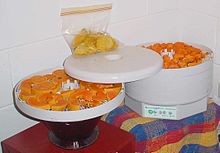- Food dehydrator
-
Food drying is a practice used to preserve fruit, vegetables and animal proteins after harvest since antiquity,[1] and a food dehydrator refers to a device that removes moisture from food to aid in its preservation. A food dehydrator uses a heat source and air flow to reduce the water content of foods. The water content of food is usually very high, typically 80% to 95% for various fruits and vegetables and 50% to 75% for various meats. Removing moisture from food restrains various bacteria from growing and spoiling food. Further, removing moisture from food dramatically reduces the weight of the food. Thus, food dehydrators are used to preserve and extend the shelf life of various foods. The first commercial food dehydrator was sold in 1920.[citation needed]
Devices require heat using energy sources such as solar or electric power, and vary in form from large-scale dehydration projects[2] to DIY projects or commercially sold appliances for domestic use. A commercial food dehydrator's basic parts usually consist of a heating element, a fan, air vents allowing for air circulation and food trays to lay food upon. A dehydrator's heating element, fans and vents simultaneously work to remove moisture from food. A dehydrator's heating element warms the food causing its moisture to be released from its interior. The appliance's fan then blows the warm, moist air out of the appliance via the air vents. This process continues for hours until the food is dried to a substantially lower water content, usually fifteen to twenty percent or less.
Most foods are dehydrated at temperatures of 130°F, or 54°C, although meats being made into jerky should be dehydrated at a higher temperature of 155°F, or 68°C, or preheated to those temperature levels, to guard against pathogens that may be in the meat. The key to successful food dehydration is the application of a constant temperature and adequate air flow. Too high a temperature can cause hardened foods: food that is hard and dry on the outside but moist, and therefore vulnerable to spoiling, on the inside.
Solar food dehydrators
Solar dryers use solar energy to create a flow of warm air through the tray. Solar food dehydrators are often cited as viable tools in the search for agricultural sustainability and food security.[3]
See also
References
- ^ "Historical Origins of Food Preservation." University of Georgia, National Center for Home Food Preservation. Accessed June 2011.
- ^ "Samuel Saraiva Project: Massive Food Dehydration to End World Hunger." The CBS Interactive Business Network. Accessed June 2011.
- ^ Scanlin, Dennis (Feb/March 1997). "The Design, Construction and Use of an Indirect, Through-Pass, Solar Food Dryer." Home Power magazine, Issue No. 57, pages 62 -72.
- MacKenzie, Jennifer; Nutt, Jay; Mercer, Don. (2009). The Dehydrator Bible. Robert Rose, Inc.
Categories:- Food preparation appliances
- Dried foods
- Kitchenware stubs
Wikimedia Foundation. 2010.


